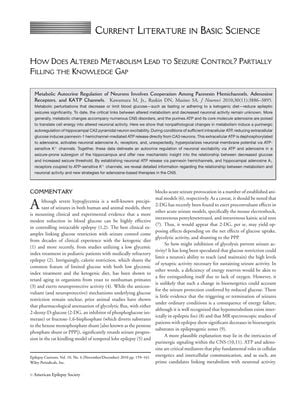How Does Altered Metabolism Lead to Seizure Control? Partially Filling the Knowledge Gap
October 2010
in “Epilepsy Currents”

TLDR Altered metabolism can help control seizures by changing brain signaling and energy use, suggesting new treatments for epilepsy.
The document from 2010 presents three separate studies exploring different mechanisms by which altered metabolism and biochemical signaling can influence seizure control. The first study by Kawamura, Ruskin, and Masino demonstrated that reduced extracellular glucose leads to the release of ATP from hippocampal neurons, which is then converted to adenosine, activating A₁ receptors and hyperpolarizing neurons, thereby increasing seizure threshold. This suggests a potential mechanism for the effectiveness of the ketogenic diet in epilepsy. The second study by Lawrence et al. highlighted the role of neurosteroids, such as allopregnanolone, in seizure control, showing that inhibiting neurosteroid synthesis increased seizure frequency in epileptic rats, indicating their importance in seizure susceptibility and potential as a treatment, especially in drug-resistant cases like catamenial epilepsy. The third study by Maroso et al. found that HMGB1 and TLR4 signaling are involved in seizure development and recurrence, with HMGB1 acting as a proconvulsant and TLR4 antagonists reducing seizure activity in rat models, suggesting this pathway as a target for treating drug-resistant epilepsies. Each study contributes to understanding the complex interactions between metabolism, signaling, and epilepsy, proposing new avenues for therapeutic intervention.
View this study on journals.sagepub.com →
Related

research How Does Altered Metabolism Lead to Seizure Control? Partially Filling the Knowledge Gap
Altered metabolism can help control seizures by changing brain signaling and energy use, suggesting new treatments for epilepsy.